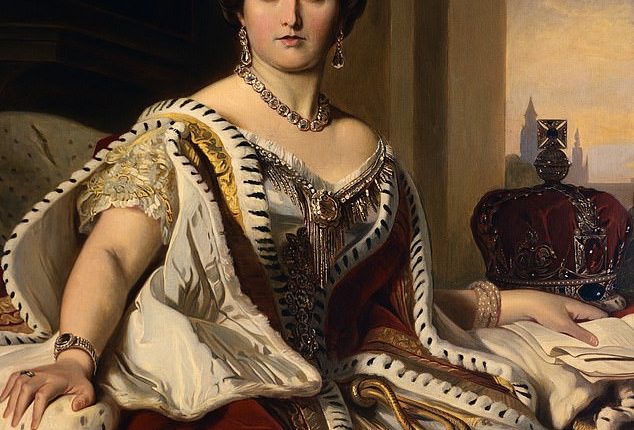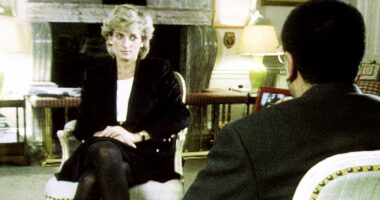Share this @internewscast.com
Despite being born 48 years apart, Queen Victoria and Queen Mary of Teck have far more in common than first meets the eye – apart from both being the matriarchs of the Royal Family.
Queen Victoria was born 206 years ago tomorrow in the same room of Kensington Palace as the then-Princess Mary of Teck almost exactly 48 years later on May 26 1867.
Mary was the great-granddaughter of King George III, making her Victoria’s first cousin once removed.
The Queen came to visit the newborn Mary and described her as ‘a very fine one, with pretty little features and a quantity of hair’.
Through her marriage to Prince George in 1893 – whose father Edward was the heir to the throne – Mary would one day become Queen too.
In many more ways Queen Victoria’s and Queen Mary’s lives were remarkably similar. Both were impacted by personal tragedy and massive societal changes taking place in Britain.

Queen Victoria’s official portrait. Victoria was born in Kensington Palace on May 24 1819

Almost exactly 48 years later, on May 26 1867, the then-Princess Mary of Teck (pictured) was born in the same room as Victoria

Queen Victoria at the christening of the future King Edward VIII with Princess Mary of Teck and Princess Alexandra of Denmark
At birth, both women’s lives could have been very different due to their parents being quite low-ranking royals in the family.
Victoria was the only child of Prince Edward, the fourth son of King George III. This meant at birth she was only fifth in line to the throne – a distance that is often enough to make the likelihood of becoming queen a slim one.
However, a number of deaths in the family – which included the King and Victoria’s own father who passed away when she was less than a year old – saw Victoria rise to third in line.
Then the death of King George IV in 1830 saw William IV crowned and Victoria became heir presumptive at just 10 years old.
Victoria’s whirlwind journey to the throne culminated with her being crowned Queen in 1837 when she was 18.
Similarly, Mary’s parents were minor royals. Her father was Prince Francis the Duke of Teck – a member of the German House of Wurttemberg dynasty which ruled over what is modern-day Stuttgart in Germany.
Her mother was Princess Mary, a fellow German from the Kingdom of Hanover.
The family were not as wealthy as you might have expected and her father had no inheritance or wealth. In order to live a more frugal existence they relocated to Florence in the 1880s.

A young Queen Mary. Her family were not as wealthy as you might have expected and her father had no inheritance or wealth

Victoria aged six. She was the only child of Prince Edward – the fourth son of King George III – meaning at birth she was only fifth in line to the throne

Mary’s parents were minor royals. Her father was Prince Francis the Duke of Teck – a member of the German House of Württemberg dynasty – her mother was Princess Mary (pictured) a fellow German from the Kingdom of Hanover

Victoria’s whirlwind journey to the throne culminated with her being crowned Queen in 1837 when she was just 18 years old
By the end of the decade the family had returned to London and she became engaged to Prince Albert, the eldest son of the Prince of Wales.
But tragedy struck when he died from pneumonia just six weeks later.
With the help of Queen Victoria, Mary then became engaged to Albert’s younger brother George who was now second in line to the throne. They married on July 6 1893.
Just 17 years later Mary became Queen consort in 1910 when her husband succeeded his father as King.
Following their marriages, Queen Victoria and Queen Mary had plenty of children – giving birth to nine and six respectively – but both were known to be somewhat distant towards their offspring.
Victoria wrote that she found pregnancy difficult and was uncomfortable in the presence of children but, like many women at the time, a large family was her ambition.
Their first child, Victoria, was born in 1840. The Princess Royal was followed by Albert Edward (1841), Alice (1843), Alfred (1844), Helena (1846), Louise (1848), Arthur (1850), Leopold (1853) and Beatrice (1857).
The day-to-day care of her children was delegated to governesses including Baroness Louise Lehzen – who had been a major supporter of Victoria while she grew up under the draconian Kensington System administered by her controlling mother.

Queen Mary was initially engaged to marry Prince Albert. But tragedy struck when he died from pneumonia just six weeks later

A family portrait of Queen Victoria and Prince Albert. Victoria wrote that she found pregnancy difficult and was uncomfortable in the presence of children

Queen Mary and King George V and a young King Edward VIII. With the help of Queen Victoria, Mary married George who was now second in line to the throne

Queen Victoria at her wedding to Prince Albert in 1840
Similarly, Mary was a hands-off mother to her six children.
Edward was born in 1894. He was followed by Albert, later King George VI (1895), Mary (1897), Henry (1900), George (1902) and John (1905).
Both Mary and Prince George failed to notice the abuse of Edward and Albert at the hands of their nanny who would often pinch the two boys.
King Edward VIII, when he heard of his mother’s death in 1953, wrote: ‘Mother could have been so hard and cruel towards her eldest son for so many years and yet so demanding at the end without relenting a scrap.
‘I’m afraid the fluids in her veins have always been as icy cold as they are now in death.’
Nevertheless, it still remains clear that both Queens loved and cherished their children dearly.
Victoria had marble sculptures made of each of her nine children – produced from casts taken of them while they were asleep.
And Edward wrote fondly about Mary in his memoirs: ‘Her soft voice, her cultivated mind, the cosy room overflowing with personal treasures were all inseparable ingredients of the happiness associated with this last hour of a child’s day.

Queen Mary with her children Prince Henry and Princess Mary

A future King George V and Princess Mary in 1893. Both Mary and Prince George failed to notice the abuse of Edward and Albert at the hands of their nanny who would often pinch the two boys
‘Such was my mother’s pride in her children that everything that happened to each one was of the utmost importance to her. With the birth of each new child, Mama started an album in which she painstakingly recorded each progressive stage of our childhood.’
Tragically, the two women also suffered their fair share of grief during their long reigns.
Victoria’s husband of 21 years, Prince Albert, died in 1861, aged only 42.
The Queen was devastated. At a Privy Council meeting three weeks after his death she could not utter a word.
She wrote to her uncle Leopold: ‘The poor fatherless baby of eight months is now the utterly broken-hearted and crushed widow of forty-two! My life as a happy one is ended! The world is gone for me!’
Victoria wore black for the rest of her life and her sharp withdrawal from public life lasted ten years.
The monarch almost obsessively tried to keep the presence of Albert in the lives of her nine children. At one of her son’s weddings, she insisted the siblings pose around a bust of Albert.

Victoria and Albert pose for a official photograph. His death at just 42 left the Queen devastated

Prince Leopold (pictured) who died from a cerebral hemorrhage aged 30. Writing about his death in her journal, Victoria said: ‘Another awful blow has fallen upon me and all of us today’
Meanwhile, the death of King George V in 1936 brought an end to his and Mary’s 43 years of marriage – meaning they were married for longer than Albert was alive.
Mary issued a message of gratitude to the nation for their condolences after the King’s death, expressing her appreciation for their support.
Her life differs from that of her cousin’s at this point as with the death of Prince Albert Victoria was still sovereign while Mary ceased being Queen Consort and instead became the Queen Mother.
In her new role she lived through a tumultuous period of the 1930s when her son, King Edward VIII, abdicated the throne in order to marry American divorcee Wallis Simpson.
Although she was supportive of her son, Mary could never understand why he would neglect his royal duties.
When the timid Prince Albert became George VI she saw it as her duty to provide moral support to the new King alongside his wife Elizabeth.
Yet another devastating similarity which permeates their lives is the death of their children.
Three of Victoria’s nine children died before her. Her second eldest daughter, Princess Alice died, when she was 35 from diphtheria on December 14 1878 – on the 17th anniversary of Prince Albert’s death.

At one of her son’s weddings, Victoria insisted her children pose around a bust of Albert. Pictured in 1863

Queen Mary’s sons Prince John (left) and Prince George (right) both died before their mother
Victoria described the coincidence of the date as ‘incredible’ and ‘mysterious’.
In a letter to her eldest daughter, Victoria, the queen wrote: ‘My precious child, who stood by me and upheld me seventeen years ago on the same day taken, and by such an awful and fearful disease.
‘She had darling Papa’s nature, and much of his self-sacrificing character and fearless and entire devotion to duty!’
Tragedy struck the Royal Family again in 1884 when Victoria’s youngest son Leopold died aged 30.
Leopold had hemophilia and was holidaying in Cannes, the south of France, when he slipped and fell, causing him to suffer a cerebral hemorrhage.
Writing about his death in her journal, his mother said: ‘Another awful blow has fallen upon me and all of us today.
‘My beloved Leopold, that bright, clever son, who had so many times recovered from such fearful illness, and from various small accidents, has been taken from us!
‘To lose another dear child, far from me, and one who was so gifted, and such a help to me, is too dreadful!’

Queen Mary in 1937. As Queen Consort she lived through a tumultuous period of the 1930s when her son King Edward VIII abdicated the throne

Queen Victoria. Following her husband’s death she wore black for the rest of her life
Victoria’s son Alfred died from throat cancer in July 1900 just months before Victoria died in January 1901.
Of Mary’s six children, three died before her.
In 1919 Mary’s youngest child, Prince John, died aged 13.
The Prince had severe epilepsy and what is now speculated to have been autistic. He was known as the ‘Lost Prince’ because he was kept away from the public eye.
He was sent to live in a house on the Sandringham estate as his condition deteriorated, and he died in 1919 at the age of 13 after suffering a severe seizure.
Upon his death, Mary described his death as a ‘great relief’ to a close friend.
‘For [John] it is a great relief, as his malady was becoming worse as he grew older, and he has thus been spared much suffering.
‘I cannot say how grateful we feel to God for having taken him in such a peaceful way, he just slept quietly into his heavenly home, no pain no struggle, just peace for the poor little troubled spirit,’ Mary said.

Queen Mary with Queen Elizabeth II (left) and the Queen Mother (right) at the funeral of King George VI. The loss of a third child had a profound impact on Queen Mary
During World War Two, the Royal Family, like thousands across the UK, suffered the loss of family members. This included the death of Mary’s son Prince George.
He was one of 15 passengers killed in the Dunbeath air crash in August 1942.
The plane crashed into the Scottish Highlands while on a routine flight from RAF Invergordon to RAF Reykjavik.
Mary also outlived her son King George VI, who died in February 1952 from cancer – just over a year before Mary passed away in March 1953.
The loss of a third child had a profound impact on Queen Mary. She reportedly told Princess Marie Louise, grandaughter of Queen Victoria: ‘I have lost three sons through death, but I have never been privileged to be there to say a last farewell to them.’
Finally, during their long lives both Queen Victoria and Queen Mary lived to see massive societal changes in the United Kingdom.
When Victoria was born in 1819 the light bulb had not been invented and the horse-drawn carriage was the main mode of transportation.
By the end of her reign the white heat of the industrial revolution had brought marvelous inventions to Britain, including steam trains that cut journey times from days to mere hours.
On top of this Victoria had overseen the sun rise on the British Empire, which became the world’s most powerful superpower of the 1800s.
She also ushered in the era of constitutional monarchy, which saw the Queen swap hard power for influence over British politics. It remains the system of government in Britain to this day.

Queen Victoria with a then-Princess Mary and Prince George in 1893. During their long lives both Queen Victoria and Queen Mary lived to see massive societal changes in the United Kingdom

Queen Victoria’s funeral in 1901. Queen Victoria is now one of the most famous monarchs to have ever ruled – second only to Queen Elizabeth II – with her cultural impact continuing to this day
Meanwhile, Queen Mary’s life was permeated by periods of deadly wars, which led to the rapid development of new forms of warfare.
She was Queen Consort during World War One and the Queen mother during World War Two. In the latter she reportedly would visit troops and directed the gatherings of scrap materials.
Mary was born at a time when cavalry charges were still common in war and lived to see the invention of the hydrogen bomb – the most devastating weapon mankind has ever created.
She was also Queen when the Empire reached its peak in 1920, covering approximately one quarter of the world, and by the time of her death decolonisation had begun.
In death, both women have left a lasting legacy in Britain.
Queen Victoria is now one of the most famous monarchs to have ever ruled – second only to Queen Elizabeth II – with her cultural impact continuing to this day.
Queen Mary is remembered as a ‘grand Queen’ who was ‘above politics’ as well as an avid collector of antiques. Many of her most treasured items – including her Dolls House – are on display in Windsor Castle.







